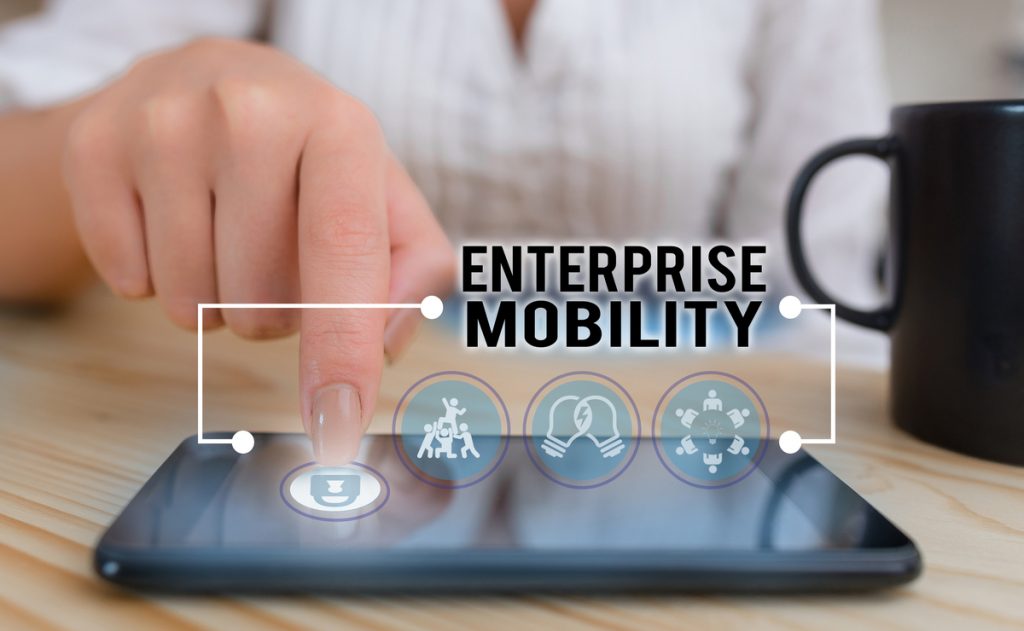Mobility has become very big. It has transformed the way businesses interact with customers and is now affecting the way people, processes, and technology interact with the ecosystem. The most compelling thing is the speed and scale at which mobility is being adopted and the way it is emerging as a key initiative. No matter what stage a business is in, there is a massive potential for businesses to grow by exploiting a technology like mobility. Therefore, enterprise mobile strategies can provide solutions that best fit their needs and assist them their long-term goals.
Definition
An enterprise mobile strategy is a framework that encompasses technology, business, people, projects, and processes into one sphere. The integration of mobility as a technology with the rest of the ecosystem allows organizations to define and practice mobile engagement. Moreover, the enterprise mobility strategy gives the flexibility to tap into future evolution and adjust strategy based on technological advancements, as and when they occur.
Importance of mobility for leaders across industries
Knowing how mobility is an essential element for personal and corporate lives, some enterprises are brainstorming to identify and implement strategies that help in mobilizing operations. The last decade observed an increase in demand for mobility solutions so that customers, as well as employees, can perform functions on the mobile devices, thus eliminating desktops. Therefore, everyone in the organization, including CIOs and CTOs who spend most of their time overseas doing business expansion and business management, has accepted mobility as an integral part of their enterprise infrastructure.
Not surprisingly, the enterprise mobility market is expected to reach USD 2.2 billion by 2022.
However, with the rising number of mobility projects and initiatives taken in the direction, CEOs should be taking care of a few elements, failing in which, business growth can decline.
The first one, security, should be the foundation of every organization apart from productivity and performance. Organizational advancements are equal to zero if the devices and data are vulnerable to attacks or theft.
The second one is, productivity, to boost organizational performance, there are several mobility tools to trade information such as sending requests, access management, and adding comments in the document.
Third and most essential, contextuality, wherein organizations need to gather information on device usage. It will show how employees are using mobile devices, when they use it, what apps and features they use, examine the results, and compare them with high-scoring departments and teams. It will work toward putting best practices in place and translate into an overall effectiveness.
Levels of enterprise mobile maturity
There are certain levels which every application should adhere to to stand firm in the market. With the launch of the app store, businesses got a great chance to enhance their customer experience by building their own applications. But, being static, they were just another replica of the website delivering no added value. Next came the scenario of dynamic apps that enabled the customer to handle things effectively and increased customer engagement. After that, and currently in the deployment stage, AI-driven apps or intelligent apps are doing justice to the businesses as well as customers.
What is the need for enterprise mobility strategy?
There is a limitation in working on the desktop for dynamic job roles these days. It limits the efficiency and productivity of the employees. In the organizational aspect, it can lead to poor adoption rates, lower engagement, and failure in achieving the desired ROI. Thus, mobilizing the operations is beneficial as it not only increases productivity but gives employees access to the backend system, raising their morale and ownership.
Below are the achievements of an organization after adopting enterprise-wide mobile strategy:
- New revenue streams
- Brand awareness
- Better customer experience
- Faster decision making
- High employee morale
- Reduced infrastructural cost
- Easy collaboration
Not only this,
Creating an enterprise mobile strategy can help in solving complex challenges and acquire a new customer base. There will be better data security, real-time data analytics, and improved communication across the organization.
Evident from the current pandemic, people working from their homes and distant locations can access their systems through VPN and maintain streamlined processes. The conference calls and stand-up meetings—ensuring everyone is doing their job right while maintaining their work-life balance—are great instances of successful mobility solutions.
Key considerations
Despite the benefits, creating mobile solutions for an enterprise can get challenging if you overlook some of the basics. It is essential to understand certain critical aspects of creating an effective mobile strategy. These aspects can help in knowing that there is consistency, seamless integration, and real-time data syncing.
1. Changing consumer preferences
It is well said that change is the only constant. In the age of digital evolution and the race to customer satisfaction, your mobile strategy should consider a few things deeply, such as who are the customers, what are their pain points, and how do they prefer communicating.
2. Current inefficiencies
One of the major reasons why enterprises prefer a mobile strategy is to streamline processes.
To eliminate the inefficiencies and introduce the right tools to the organizations, the mobile strategy helps in analyzing whether the inefficiencies are people-oriented or process-oriented, what is the way to eliminate the middleman, what are the difficulties related to information accessibility, and where lie the maximum blind spots.
3. Security and compliance
The information available on the public platform for the use of multiple entities can face security issues. Also, there are wide chances of a data breach, viruses, and malware attacks affecting the crucial data of an organization.
There should be a holistic approach toward security questioning—what security measure is taken for backend integration, and how its monitoring is done for the transaction between client and backend servers.
4. Identifying functional priorities
Though there are ample functions across the organization that can be covered under the mobile strategy, it is important to prioritize a few based on budget and convenience, such as quick wins of every service, removal of the strategy that applies to only one department, and pick one that works across all.
Conclusion
The enterprise mobile strategy is not a wonder today; it is ubiquitous across the entire business marketplace. Organizations are trying to amp up their service, and products cannot ignore the advancements and developments coming up into the world of mobility.
Mobile strategy, in a way, empowers you with the flexibility to adapt to the change that comes in the business environment. It helps in the integration of people, functions, and processes. A strategy developed with true consideration and planning can help in optimizing results and maximizing ROI. Though it requires analysis of the application installation, once it sits in the organization, there is no turning back. It can be used to attract new customers and offer more value to the existing ones.
Businesses of today and tomorrow should deep dive into mobile enterprise strategy to remain competitive or take the next plunge by being receptive to change. To know more about Enterprise Mobility, you can download our latest whitepapers on Mobility.













